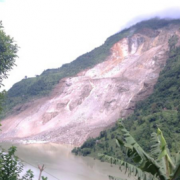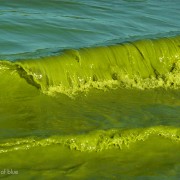New Mexico Oil Production Is Soaring. Now What To Do With The Wastewater?
State lawmakers pass bill to facilitate reusing salty water from the oil fields.

A drilling rig explores for oil in southeast New Mexico’s Permian Basin, one of the most productive sources of shale oil in the United States. Photo © Keith Schneider / Circle of Blue
By Brett Walton,Circle of Blue
With fossil fuel production in the Permian basin reaching ever greater heights, New Mexico lawmakers moved to clarify the legal status of the salty, chemical-laden water that gushes from wells in larger volumes than even the oil that is the object of the hunt.
There are compelling needs from every angle.” — Rep. Nathan Small
The New Mexico House and Senate passed HB 546 last week, a bill with broad, bipartisan support that defines ownership and liability for the “produced” water that flows from oil wells alongside hydrocarbons. The Legislature’s aim is to set the ground rules for reusing produced water, which, in an arid region, is a source of growing interest from lawmakers, regulators, oil companies, and investors.
Facilitating recycling, strengthening regulatory oversight, and conserving scarce fresh water are the purposes of the bill, says Rep. Nathan Small, the original sponsor of the legislation.
“There are compelling needs from every angle,” Small, a Democrat from Las Cruces, told Circle of Blue.
The bill, called the Produced Water Act for short, authorizes a state commission to set standards for reusing produced water outside the oil fields, potentially for irrigation, construction, industrial, or environmental purposes. It establishes requirements for when to used produced water over fresh water in oilfield operations. And it also reinstates the power of state oil and gas regulators to levy penalties for spills and leaks.
“I think it’s about time we have this [law],” Jeri Sullivan Graham, a research professor at the University of New Mexico’s Center for Water and the Environment and president of the New Mexico Desalination Association, told Circle of Blue. “The interest in produced water has been so high, and the thoughts about potentially using it even outside of oil and gas are out there. It’s a complex enough system without having to wonder about who owns it, when and where, and who’s liable. So this definitely will be a good foundational thing to do and have in place.”
Setting the Rules
The legislative changes are in response to an oil industry in southeastern New Mexico that has moved from hot to sizzling. (“Almost mind-boggling,” according to Small.) Oil production climbed 46 percent in 2018, to 250 million barrels. The state ranks third in U.S. output, behind Texas, with which it shares the highly productive Permian basin, and North Dakota.
With the oil comes even more water. More than 1 billion barrels of produced water flowed from the state’s oil wells in 2018, according to regulators. That is nearly 130,000 acre-feet, or 30 percent more water than the Albuquerque-Bernalillo County Water Utility Authority supplied last year to 660,000 people in the state’s largest metro area.
Produced water is a combination of two sources: the water-chemical-sand mixture that is pumped into an oil well during the hydraulic fracturing, or fracking, process and water that is present naturally deep underground.
Historically, produced water has been reinjected into oil reservoirs to maintain their pressure, or it was regarded as a waste product and dumped deep underground. But in a dry region that is getting drier, such large volumes of water, even tainted, are attractive.
“I think the reason that there is so much interest in reusing produced water is because those numbers are so big,” Bruce Thomson, a University of New Mexico civil engineering professor who studies produced water, told Circle of Blue. “Geez, a hundred thousand acre-feet,” he continued, in an awestruck tone at the volumes potentially in play.
The bill nudges oil operators in the direction of reuse, and in some cases mandates it. After July 1, it prohibits any contract that bars the use of produced water in oil and gas operations, such as for fracking. A few companies are already headed in that direction. Occidental Petroleum set a target of using 95 percent treated produced water for its fracking jobs in New Mexico in 2018. The company did not immediately respond to a question about whether it met that goal. (Fracking used 13,000 acre-feet of water in New Mexico in 2018, according to the industry database FracFocus.)
The bill splits oversight of produced water between two agencies. The New Mexico Oil Conservation Division has authority over its use in oil operations and when it is injected underground as a means of disposal. The New Mexico Environment Department’s domain is produced water used for anything else.
The bill clarifies that produced water does not come with a water right attached that needs to be registered with the State Engineer’s Office. This was a point of confusion that had surfaced in past discussions with oil companies, said Scott Verhines, who was the state engineer from 2011 through 2014.
“We had a lot of meetings with industry,” Verhines told Circle of Blue. “They would say, ‘Why would we clean up this water if the state is going to take it away from us?’ The perception was that it had a water right and the state had the ability to take that water away from them if those rights weren’t being used.”
Small said that it is “the absolute, clear intent of the legislation” not to create a water right for produced water.
Another stipulation in the bill is the transfer of liability. When the company that generates the produced water sells it or gives it to another party, the receiving party takes on liability. It’s a departure from hazardous waste laws, which are a cradle-to-grave responsibility for the company that generated the waste, Thomson said.
“This bill allows transfer of responsibility from the generator, the oil and gas company, to the company that has acquired the water for subsequent reuse,” Thomson explained. “So that resolved that uncertainty, and I think that will facilitate reuse because all of a sudden the generator, the oil and gas company, doesn’t have to worry about someone a hundred miles away spilling the water and them being liable for it.”
The bill gives the Water Quality Control Commission, a 15-member body comprising state agency heads, local government representatives, and members of the public, the authority to adopt rules governing the use of treated produced water outside the oil fields. (Thomson has been nominated to the commission.)
Currently no produced water in New Mexico is used outside the oil and gas industry, but future uses that are being discussed include road construction, irrigation, or discharging into rivers or streams. The rules will then be administered by the New Mexico Environment Department. Environmental groups urge that significant scientific assessment and analysis needs to be done before using treated produced water for environmental purposes.
A Law Built on Collaboration
Legal changes, however, are just one step for increasing recycling of produced water, Thomson said. There are still substantial financial, economic, and geographical hurdles to overcome. One is treatment: produced water in New Mexico’s Permian basin is, on average, three times saltier than the ocean, plus there are fracking chemicals and naturally radioactive particles to remove as well. Then there are the logistics: moving produced water via truck is several times more expensive than by pipeline, but those pipeline networks are only just being developed.
Produced water is a topic of intense, recent interest. Industry conferences are filling up and selling out quicker than expected. Meanwhile, state and federal lawmakers are scrutinizing their rules. Last year the U.S. Environmental Protection Agency and three New Mexico regulatory agencies signed an agreement to assess existing state policies that govern reusing produced water. The agreement resulted in a draft white paper, published in November, that outlined obstacles to reuse. Some of those obstacles — questions about control, ownership, and liability — were addressed in HB 546, which passed the New Mexico House unanimously and by a vote of 32 to 6 in the Senate.
“It’s fascinating how quickly that moved from a report into a piece of legislation,” Sullivan Graham said. “I think it speaks to the need.”
There were other intersections, as well. James Kinney, the EPA official who worked on the white paper, was confirmed in February as the secretary of the New Mexico Environment Department.
Small said that the white paper did influence the bill. But collaboration with a diverse set of voices was just as important.
“This would never have worked if it were a process driven by one stakeholder group,” said Small, who expects the governor to sign the bill. “The fact that we had conservation and environmental groups, who see the overwhelming importance of safeguarding freshwater resources, step up to the table alongside agencies and alongside industry made sure that the balance got struck.”
Brett writes about agriculture, energy, infrastructure, and the politics and economics of water in the United States. He also writes the Federal Water Tap, Circle of Blue’s weekly digest of U.S. government water news. He is the winner of two Society of Environmental Journalists reporting awards, one of the top honors in American environmental journalism: first place for explanatory reporting for a series on septic system pollution in the United States(2016) and third place for beat reporting in a small market (2014). He received the Sierra Club’s Distinguished Service Award in 2018. Brett lives in Seattle, where he hikes the mountains and bakes pies. Contact Brett Walton











Leave a Reply
Want to join the discussion?Feel free to contribute!